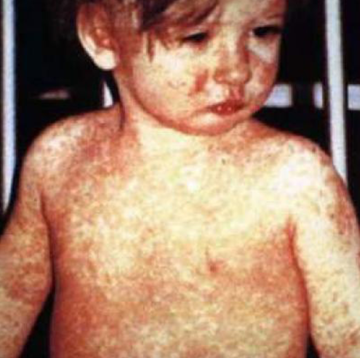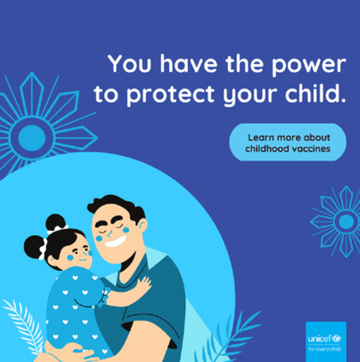Principle 6: Remind people why we vaccinate
Vaccines are a victim of their own success.
They have been so successful in eradicating deadly diseases that the diseases are often no longer visible, and people may believe that ongoing vaccination is no longer important. Try to make people feel susceptible to the threat of infection–that they or their loved ones may be at risk. Susceptibility has been associated with vaccine acceptance and uptake in a multicountry study. (1)
Messages about vaccine-preventable diseases (VPDs) should be:
- Narrative-based (as opposed to statistical)
- Always end with self-efficacy and response efficacy, meaning you must also include a solution: getting the available vaccine.
🛑 NOTE: It is important to avoid shocking the reader, as this can induce response paralysis. A scary photo made hesitant parents aware of the dangers of measles but increased belief in vaccine side effects. In another study, exposure to a photo of a child very ill with mumps increased misperceptions and significantly increased beliefs in dangerous vaccine side effects.

Measles. This photograph shows a child with classic day-4 rash with measles. (Source: CDC) Such images should be rarely used in vaccine messaging because of potential backfire effects.
Steps for effective communication about the risks of VPDs to encourage vaccination:
- An individual must perceive that they are at risk for disease (risk perception), so a message that raises the salience of the disease and makes them feel susceptible, or vulnerable, to that infection is key.
- They must believe that there is an effective action that they can take to protect themselves or their loved ones (response efficacy), which is to get a vaccination.
- They must believe that they are capable of taking that action (self-efficacy), meaning they have access to the right vaccine.
Example: UNICEF Philippines


In UNICEF Philippines, a campaign was designed to remind parents why we vaccinate. Insights revealed that those who were hesitant to vaccinate their children were concerned about vaccine safety and side effects. This message portrayed the ability of parents to protect their children from preventable diseases as a superpower, and it was delivered with a female and male character.
This message reminded parents that there was an effective action they could take to protect their children. These messages were accompanied with additional text reminding parents that vaccines were safe, effective and freely accessible throughout the Philippines. The campaign effectively strengthening parents’ perceived ability to protect their children through immunization.
Sources:
(1) Wheelock A, Miraldo M, Thomson A, et al. Evaluating the importance of policy amenable factors in explaining influenza vaccination: a crosssectional multinational study. BMJ Open 2017;7:e014668.
Average Rating: ☆ ☆ ☆ ☆ ☆ (0 reviews)


